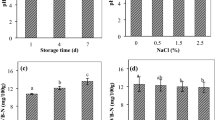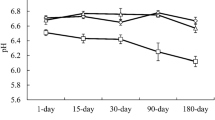Abstract
The effects of high pressure at subzero temperature (193 MPa, at −20 °C) on inactivation of natural microflora of cod meat and degradation of trimethylamine oxide (TMAO) to trimethylamine (TMA) during refrigerated storage and to dimethylamine (DMA) and formaldehyde (FA) during frozen storage were investigated. The content of TMA, DMA and FA in cod meat did not change immediately after pressure treatment. During 40 days of frozen storage of pressurized meat at −5 °C, concentration of DMA-N and FA was, respectively, about 10 and 7 times lower than in the stored unpressurized meat. It is the result of pressure-induced inactivation of cod meat TMAOase. There was no correlation between the total numbers of bacteria and TMA-N content. The total bacterial count has increased during refrigerated storage of pressurized meat, although for a short period of time more slowly than in the untreated samples. During refrigerated storage, the accumulation of TMA-N in pressurized samples was much lower than in unpressurized meat. The pressure treatment of fish meat leads to considerable reduction in enzymatic and bacterial decomposition of TMAO to DMA and TMA, respectively. Therefore, such processing can improve sensory quality of meat and allow to extend its shelf life.


Similar content being viewed by others
References
Ashie INA, Simpson BK (1996) Application of high hydrostatic pressure to control enzyme related fresh seafood texture deterioration. Food Res Int 29:5–6
Hendrickx M, Ludikhuyze L, Van Den Broeck I, Weemaes C (1998) Effects of high pressure on enzymes related to food quality. Trends Food Sci Technol 9:197–203. doi:10.1016/S0924-2244(98)00039-9
Gram L, Trolle G, Huss HH (1987) Detection of specific spoilage bacteria from fish stored at low (0°C) and high (20°C) temperatures. Int J Food Microbiol 4:65–72. doi:10.1016/0168-1605(87)90060-2
Dalgaard P, Gram L, Huss HH (1993) Spoilage and shelf-life of cod fillets packed in vacuum or modified atmospheres. Int J Food Microbiol 19:283–294. doi:10.1016/0168-1605(93)90020-H
Sikorski ZE, Kostuch S (1982) Trimethylamine N-oxide demethylase: its occurrence, properties and role in technological changes in frozen fish. Food Chem 9:216–222
Hiltz DF, Lall BS, Lemon DW, Dyer WJ (1976) Deteriorative changes during frozen storage in fillets and minced flesh of silver hake (merluccius bilinearis) processed from round fish held in ice and refrigerated sea water. J Fish Res Board Canada 33:2560–2567
Rehbein H (1988) Relevance of trimethylamine oxide demethylase activity and haemoglobin content to formaldehyde production and texture deterioration in frozen storage minced fish muscle. J Sci Food Agric 43:261–276
Sotelo CG, Gallardo JM, Pineiro C, Perez-Martin R (1995) Trimethylamine oxide and derived compounds’ changes during frozen storage of hake (Merluccius merluccius). Food Chem 53:61–65
Gou J, Choi KP, He X, Ahn J (2010) Dimethylamine, trimethylamine, and biogenic amine formation in high-pressure processed semidried squid (Todarodes pacificius) during refrigerated storage. J Food Sci. doi:10.1111/j.1750-3841.2010.01731.x
Gou J, Choi GP, Ahn J (2012) Biochemical quality assessment of semi-dried squid (todarodes pacificus) treated with high hydrostatic pressure. J Food Biochem 36:171–178. doi:10.1111/j.1745-4514.2010.00523.x
Hashizume C, Kimura K, Hayashi R (1995) Kinetic analysis of yeast inactivation by high pressure treatment at low temperatures. Biosci Biotechnol Biochem 59:1455–1458
Moussa M, Perrier-Cornet JM, Gervais P (2007) Damage in Escherichia coli cells treated with a combination of high hydrostatic pressure and subzero temperature. Appl Environ Microbiol 73:6508–6518. doi:10.1128/aem.01212-07
Kalichevsky M (1995) Potential food applications of high-pressure effects on ice-water transitions. Trends Food Sci Technol 6:253–259. doi:10.1016/S0924-2244(00)89109-8
Malinowska-Pańczyk E, Kołodziejska I, Murawska D, Wołosewicz G (2009) The combined effect of moderate pressure and chitosan on Escherichia coli and Staphylococcus aureus cells suspended in a buffer and on natural microflora of apple juice and minced pork. Food Technol Biotechnol 47:202–209
Bridgman PW (1912) Water in the liquid and five solid forms under pressure. Proc Am Acad Arts Sci XLVII:439–558
Kimura M, Seki N, Kimura I (2000) Purification and characterization of trimethylamine-N-oxide demethylase from walleye pollack muscle. Fish Sci 66:967–973
Dyer WJ (1945) Amines in fish muscle. I. Colorimetric determination of trimethylamine as the picrate salt. J Fish Res Board Canada 6:351–358
Dyer WJ, Mounsey YA (1945) Amines in fish muscle. II. Development of trimethylamine and other amines. J Fish Res Board Canada 6:359–367
Nash T (1953) The colorimetric estimation of formaldehyde by means of the Hantzsch reaction. Biochem J 55:416–421
Licciardello JJ, Ravesi EM, Lundstrom RC et al (1982) Time-temperature tolerance and physical-chemical quality tests for frozen red hake. J Food Qual 5:215–234
Leblanc EL, Leblanc RJ (1988) Effect of frozen storage temperature on free and bound formaldehyde content of cod (Gadus morhua) fillets. J Food Process Preserv 12:95–113
Gou J, Lee HY, Ahn J (2010) Effect of high pressure processing on the quality of squid (Todarodes pacificus) during refrigerated storage. Food Chem 119:471–476. doi:10.1016/j.foodchem.2009.06.042
Castell CH, Anderson GW, Pivnick H (1948) Relation of bacterial counts to quality of cod fillets. J Fish Res Board Canada 7b:378–388. doi:10.1139/f47-030
Huss HH, Dalsgaard D, Hansen L et al (1974) The influence of hygiene in catch handling on the storage life of iced cod and plaice. J Food Technol 9:213–221
Gram L, Huss HH (1996) Microbiological spoilage of fish and fish products. Int J Food Microbiol 33:121–137
Kim KE, Chang GW (1974) Trimethylamine oxide reduction by Salmonella. Can J Microbiol 20:1745–1748
Alpas H, Kalchayanand N, Bozoglu F, Ray B (2000) Interactions of high hydrostatic pressure, pressurization temperature and pH on death and injury of pressure-resistant and pressure-sensitive strains of foodborne pathogens. Int J Food Microbiol 60:33–42. doi:10.1016/S0168-1605(00)00324-X
Malinowska-Pańczyk E, Kołodziejska I, Dunajski E (2008) Effect of high pressure on selected bacteria at subzero temperature. Polish J Food Nutr Sci 58:419–424
This research project was financed by the national research budget provided for the years 2007–2010.
Author information
Authors and Affiliations
Corresponding author
Ethics declarations
Conflict of interest
None.
Compliance with Ethics Requirements
This article does not contain any studies with human or animal subjects.
Rights and permissions
About this article
Cite this article
Malinowska-Pańczyk, E., Kołodziejska, I. The effect of high pressure on formation of volatile amines in minced meat of cod (Gadus morhua). Eur Food Res Technol 242, 415–420 (2016). https://doi.org/10.1007/s00217-015-2552-5
Received:
Revised:
Accepted:
Published:
Issue Date:
DOI: https://doi.org/10.1007/s00217-015-2552-5




